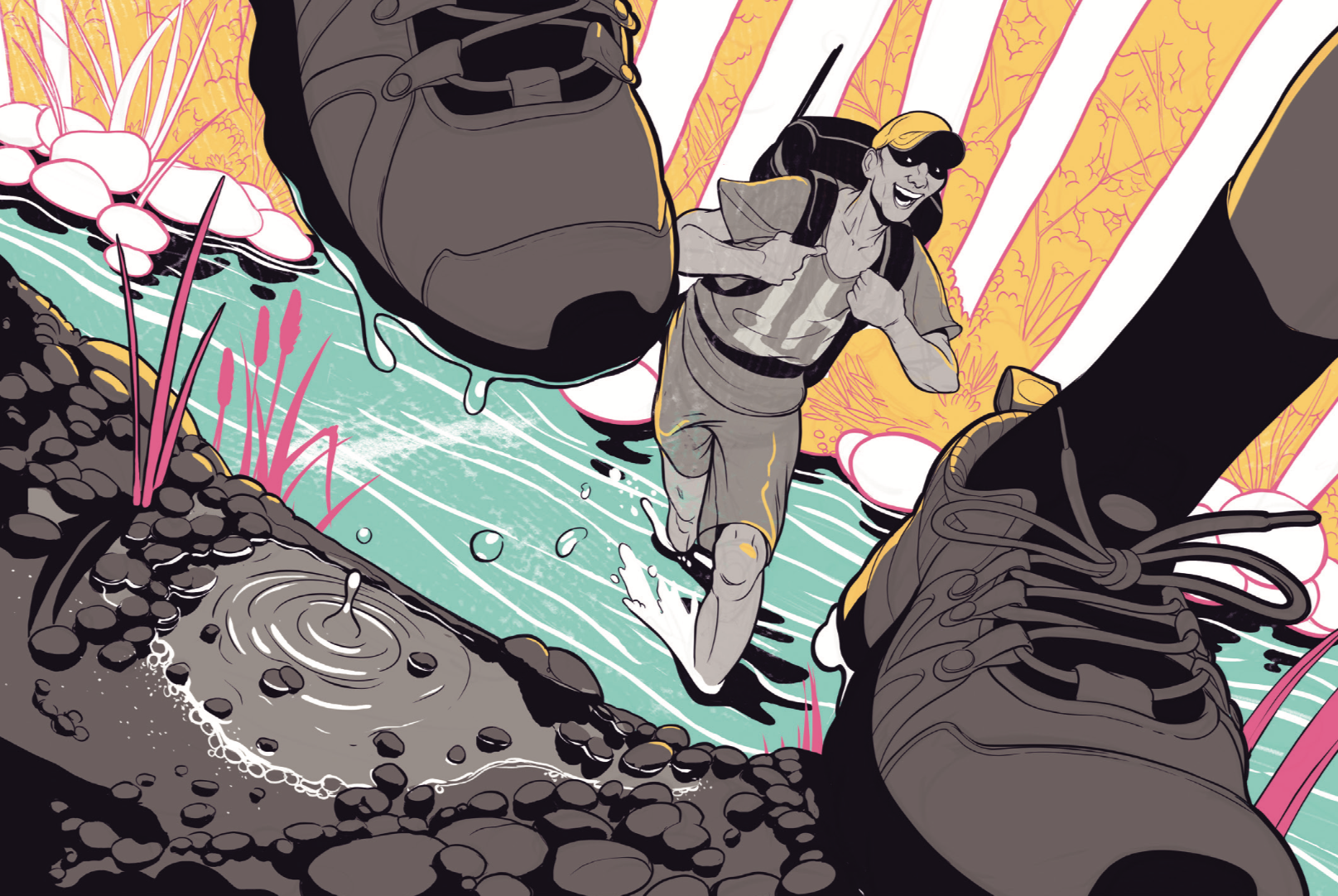Pass/Fail: Hike With Wet Feet

'Illustration by Ryan Garcia'
Cold water churned around my thighs and threatened to knock me over as I shuffled across Forney Creek. It was early spring in Great Smoky Mountains National Park, and the current was high and swift thanks to a spate of recent rains. I paused, clinging to a fallen tree for stability, and felt the cold water gushing through my shoes.
Like many hikers, I avoid sloshing through creeks. Conventional trail wisdom says that wet feet are blister- and fungus-prone. I internalized this early in my backpacking career. In the name of foot care, I’ve searched off-trail for the driest passages and even donned bread bags over my socks. Risky leaps between widely spaced stones? I’ve taken too many to count. When waterproof boots aren’t sufficient, I switch in and out of sandals for every crossing. It’s effective—but painfully slow.
This time was different. Tired of the tactical gymnastics of keeping my feet dry, I decided to simplify the process. I wanted to hike as efficiently as possible, and heading straight through water is faster than avoiding it—if there’s no foot health penalty.
My friend Glenn and I had been eyeing a three-day, 30-mile hike in the southern Smokies. The loop tagged the highest point on the Appalachian Trail and offered long views over the park’s namesake mountains. But it also required nearly a dozen river crossings with precious few footbridges or rock-hopping opportunities to spare our feet from submersion. Daytime temperatures looked to be mild, so the timing seemed right to take the plunge.
“There are six more crossings coming up,” Glenn said. He had climbed the opposite bank after the inaugural foot soaking and was studying his map. Despite the comfortable spring weather, my feet were cold, and I was starting to feel less sanguine about the whole experiment. By tomorrow, we’d have constellations of angry blisters. I just knew it.
But I’d taken some precautions. One was slathering my feet in Chamois Butt’r anti-chafing lubricant. I also packed light, figuring every extra ounce in my pack would put strain on my feet and increase blister risk.
For footwear, waterproof boots were a no-go. Overtopping them, which was inevitable on this route, would render waterproofing worse than useless, as liners trap moisture and dry slowly. I needed something lightweight. My mesh trail runners fit the bill. As for socks, the thick, cushioned ones I usually hike in would absorb too much water. I opted for thin, merino-and-nylon socks.
My shoes felt heavy as I emerged from the first crossing. Instinctively, I started to unlace them to dump them out, but what was the point? More crossings awaited. I’d braved solo trips in bear country and dodged rattlesnakes and ill-tempered feral hogs—surely I could handle a little water.
We splashed through creek after creek. Plowing straight through them was fun and let us cover the miles faster than if we’d stopped to change footwear. I crossed my fingers for the survival of my feet and rambled up the trail.
After pitching our tents and building a fire, we removed our shoes and held our feet to the flames. The skin was pruned and clammy, but there were no blisters—yet. My planning seemed to be paying off. But sores were only the first of my concerns. I knew that prolonged exposure to moisture could lead to a fungal infection called trench foot. Before slipping on fresh socks for sleeping, I rubbed Gold Bond on my feet. Dry and snug under my sleeping quilt, I started to doze.
That night, a thunderstorm rolled in. Harsh winds and heavy rain battered my tent and drenched the landscape. In the morning, the air hung thick with humidity. I smeared more anti-chafing goo on my feet and slid into a dry pair of socks. Then, I put on my cold, soggy shoes and started hiking.
“How are your feet?” Glenn asked. Our pace was brisk as we headed down from Clingmans Dome on a section of the AT. “They don’t hurt at all,” I said. By now, my inherent fear of blisters was subsiding. I was more than halfway through the hike and hadn’t felt so much as a hot spot.
The next morning, we booked it the final 6 miles to the trailhead and emerged from the Smokies blister-free. I can’t say if it was the lightweight trail runners, the end-of-day Gold Bond, or the anti-chafing ointment that made the difference. I like to think it was all three—and remaining vigilant about my feet throughout the day. Either way, there are more soggy hikes in my future.
The Verdict
We hiked with wet feet for nearly 30 miles and our feet didn’t fall apart. Soggy shoes felt uncomfortable at first, but splashing through creeks like wild animals was liberating.
Prepare for the Plunge
Choose quick-dry footwear.
Waterproof boots aren’t your friends when you’re up to your knees in water. Thin, breathable trail runners dry out much faster.
Pack extra socks.
Always bring at least three pairs of quick-drying socks. Hang wet socks on the outside of your pack during the day.
Embrace skin care products.
Rub Body Glide or Chamois Butt’r on your feet each morning to minimize friction. A coating of end-of-day Gold Bond helps absorb any remaining moisture, especially between your toes. With a diligent foot care routine, wet-feet hiking is sustainable, even for long-distance treks.
Listen to your feet.
When your body gives you feedback, take its advice. Tend to hot spots immediately. Dry and clean your feet at the first feelings of itching, pain, or numbness, which can be indications of trench foot.